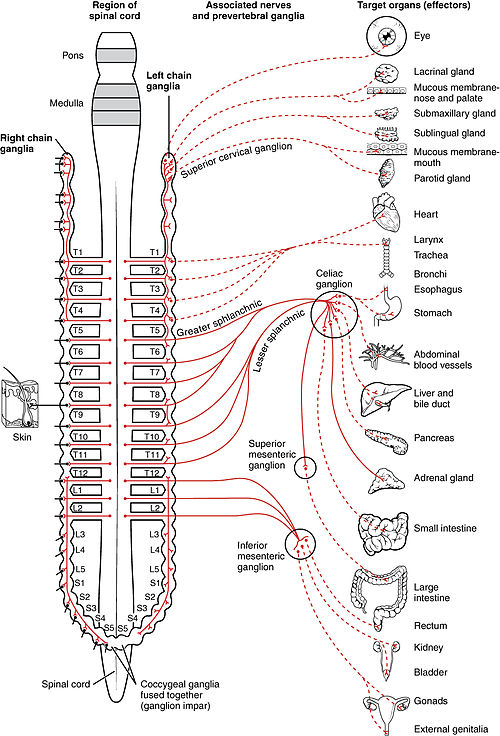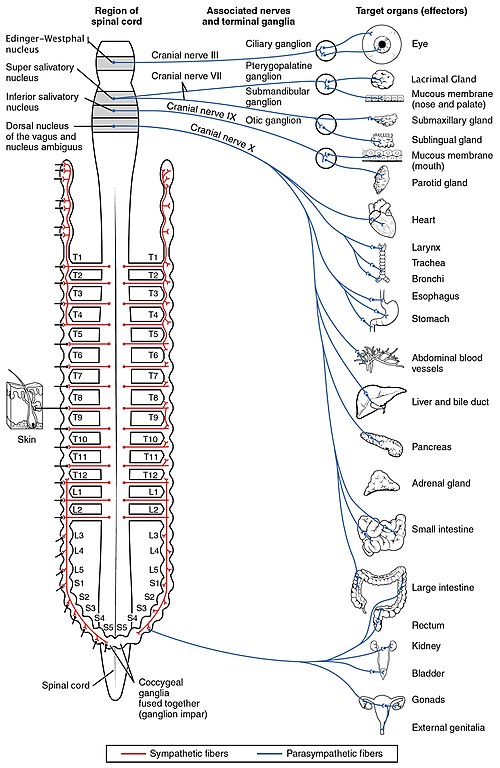8.4 Autonomic Nervous System
Autonomic Nervous System[1]
In addition to the endocrine system, the autonomic nervous system is instrumental in maintaining homeostasis in the body. The autonomic nervous system regulates many of the body’s internal organs through a balance of two divisions called the sympathetic division and the parasympathetic division. The sympathetic system is associated with the “fight-or-flight response,” and the parasympathetic system is associated with the “rest and digest” response. These two branches have opposite effects and are considered antagonistic to each other. Most organs have both a sympathetic and parasympathetic nerve innervating them (dual innervation). The sympathetic division will increase body activities that are crucial for survival in a potentially dangerous situation and will decrease body activities that aren’t essential. The parasympathetic division does the opposite of the sympathetic branch. It increases activities like digestion and decreases others like heart rate and blood pressure.
For example, the heart receives stimuli from both the sympathetic and parasympathetic divisions. The sympathetic nervous system increases heart rate whereas the parasympathetic nervous system decreases it.
Sympathetic Nervous System
The “fight-or-flight response” of the sympathetic nervous system prepares the body to either run away from a threat or to stand and fight. The autonomic system controls the physiological response to make that possible. Epinephrine (adrenaline) is released in the circulatory system, causing the heart rate to increase. Sweat glands become active. The bronchi of the lungs dilate to allow more air exchange. Pupils dilate to increase visual information. Blood pressure increases and blood vessels dilate to allow more oxygen-rich blood to reach the skeletal muscle for anticipated movement. The autonomic nervous system creates emotional reactions associated with anxiety, and the corresponding physiological reactions can feel like a panic attack.
When responding to a real or perceived threat, the sympathetic system activates many organs for a common purpose of fighting or fleeing. The respiratory, cardiovascular, and musculoskeletal systems are activated together to allow more oxygen to be inhaled and delivered to skeletal muscle. Sweating prevents the body from overheating from the excess heat resulting from muscle contraction. The digestive system shuts down to divert more blood to deliver oxygen to skeletal muscles instead of absorbing nutrients. To coordinate all these responses, the connections in the sympathetic system diverge from a limited region of the central nervous system (CNS) to a wide array of organs simultaneously.
The sympathetic division of the autonomic nervous system controls the various organ systems of the body through connections emerging from the thoracic and upper lumbar spinal cord. Because of this, the sympathetic nervous system is also referred to as the thoracolumbar system. A diagram that shows the connections of the sympathetic system is somewhat like a circuit diagram that shows the electrical connections between different receptacles and devices. Neurons from the spinal cord travel to ganglia and then project to target effectors throughout the body. See Figure 8.32[2] for an illustration of the connections of the sympathetic division of the autonomic nervous system.

Fight-or-Flight Response
Watch this supplementary YouTube video[3] to learn more about adrenaline and the fight-or-flight response: Fight or Flight Response
Adrenaline, also known as epinephrine, is an important hormone in coordinating the body’s fight-or-flight response. In this video, what two changes does adrenaline bring about to help the skeletal muscle response?
Parasympathetic Nervous System
In contrast to the “fight-or-flight” responses by the sympathetic nervous system, the parasympathetic nervous system responses are commonly known as “rest and digest.” This system is normally in charge of the body and helps maintain normal homeostasis. An acronym associated with some functions of the parasympathetic nervous system is SLUDD, which stands for salivation, lacrimation, urination, digestion, and defecation. The parasympathetic nervous system reverses the effects of fight or flight, helping return the body to its normal resting state.
The parasympathetic system is also referred to as the craniosacral system because the preganglionic neurons are located in the brain stem and the sacral spinal cord. Neurons from the brain stem and sacral spinal cord project to terminal ganglia near or within the various organs of the body. Axons from these ganglionic neurons then project the short distance to those target effectors. See Figure 8.33[4] for an illustration of the connections of the parasympathetic division of the autonomic nervous system.

Autonomic Tone
The functioning of organ systems is balanced by input from the sympathetic and parasympathetic nervous systems. If something upsets that balance, feedback strives to return it to normal. Additionally, each organ system may have a more sympathetic or parasympathetic tendency in its resting state, known as the autonomic tone of the system. For example, the resting heart rate is the result of the parasympathetic system slowing the heart down from its intrinsic rate of 100 beats per minute, so the heart is said to be in parasympathetic tone.
- Betts, J. G., Young, K. A., Wise, J. A., Johnson, E., Poe, B., Kruse, D. H., Korol, O., Johnson, J. E., Womble, M., & DeSaix, P. (2022). Anatomy and physiology 2e. OpenStax. https://openstax.org/books/anatomy-and-physiology-2e/pages/1-introduction ↵
- “1501_Connections_of_the_Sympathetic_Nervous_System” by OpenStax College is licensed under CC BY 3.0 ↵
- Bozeman Science. (2012, January 9). Fight or flight response [Video]. YouTube. All rights reserved. https://www.youtube.com/watch?v=m2GywoS77qc ↵
- “1503_Connections_of_the_Parasympathetic_Nervous_System” by OpenStax College is licensed under CC BY 3.0 ↵
Part of the autonomic nervous system responsible for the "fight or flight" response.
Part of the autonomic nervous system that promotes "rest and digest" functions.
Controlled by the sympathetic division of the autonomic nervous system.
Controlled by the parasympathetic division of the autonomic nervous system. It focuses on calming the body, lowering heart rate, and stimulating digestion during periods of rest.
Another name for the sympathetic nervous system.
An acronym associated with some functions of the parasympathetic nervous system and stands for Salivation, Lacrimation, Urination, Digestion, and Defecation.
Another name for the parasympathetic nervous system, referring to its nerve origins in the brain stem (cranial) and sacral spinal cord regions.
Balance between the sympathetic and parasympathetic nervous systems.

